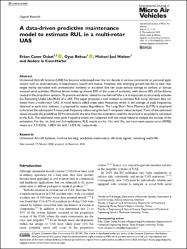| dc.contributor.author | Özkat, Erkan Caner | |
| dc.contributor.author | Bektaş, Oğuz | |
| dc.contributor.author | Nielsen, Michael Juul | |
| dc.contributor.author | la Cour-Harbo, Anders | |
| dc.date.accessioned | 2023-08-23T06:52:28Z | |
| dc.date.available | 2023-08-23T06:52:28Z | |
| dc.date.issued | 2023 | en_US |
| dc.identifier.citation | Özkat, E.C., Bektaş, O., Nielsen, M.J. & la Cour-Harbo, A. (2023). A data-driven predictive maintenance model to estimate RUL in a multi-rotor UAS. International Journal of Micro Air Vehicles, 15. https://doi.org/10.1177/175682932211501 | en_US |
| dc.identifier.issn | 1756-8293 | |
| dc.identifier.issn | 1756-8307 | |
| dc.identifier.uri | https://doi.org/10.1177/175682932211501 | |
| dc.identifier.uri | https://hdl.handle.net/11436/8112 | |
| dc.description.abstract | Unmanned Aircraft Systems (UAS) has become widespread over the last decade in various commercial or personal applications such as entertainment, transportation, search and rescue. However, this emerging growth has led to new challenges mainly associated with unintentional incidents or accidents that can cause serious damage to civilians or disrupt manned aerial activities. Machine failure makes up almost 50% of the cause of accidents, with almost 40% of the failures caused in the propulsion systems. To prevent accidents related to mechanical failure, it is important to accurately estimate the Remaining Useful Life (RUL) of a UAS. This paper proposes a new method to estimate RUL using vibration data collected from a multi-rotor UAS. A novel feature called mean peak frequency, which is the average of peak frequencies obtained at each time instance, is proposed to assess degradation. The Long Short-Term Memory (LSTM) is employed to forecast the subsequent 5 mean peak frequency values using the last 7 computed values as input. If one of the estimated values exceeds the predefined 50 Hz threshold, the time from the estimation until the threshold is exceeded is calculated as the RUL. The estimated mean peak frequency values are compared with the actual values to analyze the success of the estimation. For the 1st, 2nd, and 3rd replications, RUL results are 4 s, 10 s, and 10 s, and root mean square error (RMSE) values are 3.7142 Hz, 1.4831 Hz, and 1.3455 Hz, respectively. | en_US |
| dc.language.iso | eng | en_US |
| dc.publisher | Sage Publications | en_US |
| dc.rights | info:eu-repo/semantics/openAccess | en_US |
| dc.subject | Unmanned aircraft systems | en_US |
| dc.subject | Machine learning | en_US |
| dc.subject | Predictive maintenance | en_US |
| dc.subject | Vibration signals | en_US |
| dc.subject | Remaining useful life | en_US |
| dc.title | A data-driven predictive maintenance model to estimate RUL in a multi-rotor UAS | en_US |
| dc.type | article | en_US |
| dc.contributor.department | RTEÜ, Mühendislik ve Mimarlık Fakültesi, Makine Mühendisliği Bölümü | en_US |
| dc.contributor.institutionauthor | Özkat, Erkan Caner | |
| dc.identifier.doi | 10.1177/17568293221150171 | en_US |
| dc.identifier.volume | 15 | en_US |
| dc.relation.journal | International Journal of Micro Air Vehicles | en_US |
| dc.relation.tubitak | TUBITAK-2219 | |
| dc.relation.publicationcategory | Makale - Uluslararası Hakemli Dergi - Kurum Öğretim Elemanı | en_US |


















